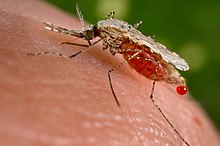Taxonomy of Anopheles
| Anopheles | |
|---|---|
 |
|
| Anopheles stephensi | |
| Scientific classification | |
| Kingdom: | Animalia |
| Phylum: | Arthropoda |
| Class: | Insecta |
| Order: | Diptera |
| Superfamily: | Culicoidea |
| Family: | Culicidae |
| Subfamily: | Anophelinae |
| Genus: | Anopheles |
| Subgenera | |
|
|
Anopheles is a genus of mosquitoes (Culicidae). Of about 484 recognised species, over 100 can transmit human malaria, but only 30–40 commonly transmit parasites of the genus Plasmodium that cause malaria, which affects humans in endemic areas. Anopheles gambiae is one of the best known, because of its predominant role in the transmission of the deadly species Plasmodium falciparum.
The classification of this genus began in 1901 with Theobald. Despite the passage of time, the taxonomy remains incompletely settled. Classification into species is based on morphological characteristics - wing spots, head anatomy, larval and pupal anatomy, and chromosome structure, and more recently on DNA sequences.
The genus Anopheles belongs to a subfamily Anophelinae with three genera: Anopheles Meigen (nearly worldwide distribution), Bironella Theobald (Australia only: 11 described species) and Chagasia Cruz (Neotropics: four described species). The genus Bironella has been divided into three subgenera: Bironella Theobald (two species), Brugella Edwards (three species) and Neobironella Tenorio (three species). Bironella appears to be the sister taxon to the Anopheles, with Chagasia forming the outgroup in this subfamily.
The type species of the genus is Anopheles maculipennis.
The genus has been subdivided into seven subgenera based primarily on the number and positions of specialized setae on the gonocoxites of the male genitalia. The system of subgenera originated with the work of Christophers, who in 1915 described three subgenera: Anopheles (widely distributed), Myzomyia (later renamed Cellia) (Old World) and Nyssorhynchus (Neotropical). Nyssorhynchus was first described as Lavernia by Theobald. Edwards in 1932 added the subgenus Stethomyia (Neotropical distribution). Kerteszia was also described by Edwards in 1932, but then was recognised as a subgrouping of Nyssorhynchus. It was elevated to subgenus status by Komp in 1937; this subgenus is also found in the Neotropics. Two additional subgenera have since been recognised: Baimaia (Southeast Asia only) by Harbach et al. in 2005 and Lophopodomyia (Neotropical) by Antunes in 1937.
...
Wikipedia
